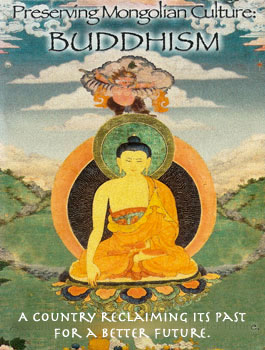2. Highlights & Heroes of Mongolian Buddhism
Practiced in Secret
The Arkhangai Monastery, once a thriving community of monks, was one of hundreds of monasteries destroyed. The survivors of this lineage continue to practice in a ger near the site.
For 70 years, Buddhism was practiced in secret. The flame of faith kept alive through the quiet devotion of many Mongolian people. Much of the art and literature of Mongolia’s precious history was buried or hidden to save them from destruction. These relics were found in the backyard of the prominent Buddhist nunnery, Dara Ekh.
In 1938, the curator of the Rabjaa Museum hid the entire collection of relics belonging to the famous Kharmapa Lama, Dandan Rabjaa, in a series of seventeen caves. He told no one of the location until 1965, when he passed the curatorship to his grandson, only 5 years old at the time. Here (photo), Altangerel holds the snuff bottle given to him by his grandfather as a symbol of the position of curator of the Rabjaa Museum. Altangerel restored the treasures to the museum in 1991.
At the end of the 19th century, a prophecy was written about the future of Buddhism in Mongolia.
|
The Arkhangai Monastery, once a thriving community of monks, was one of hundreds of monasteries destroyed. The survivors of this lineage continue to practice in a ger near the site. |
Архангай аймагт орших энэхүү сүм бол аймшигт хэлмэгдлийн үед устгалд өртөж, сүйрсэн тэрхүү зуу зуун сүмийн зөвхөн нэг нь. Амьд үлдсэн цөөн хэдэн лам нар нь одоо, хуучин сүм байсан газраасаа холгүйхэн гэр хийдэд шавилан ном хурж байна. | |
|
For 70 years, Buddhism was practiced in secret. The flame of faith kept alive through the quiet devotion of many Mongolian people. Much of the art and literature of Mongolia’s precious history was buried or hidden to save them from destruction. These relics were found in the backyard of the prominent Buddhist nunnery, Dara Ekh. |
Аймшигт далаад жилийн турш Монголчууд бурханы шашнаа далд, нууцаар, шүтэж байв. Хэдийгээр нууцгайхан байвч итгэл бишрэлийн гал Монголын сүсэгтэн олны зүрхэнд чимээгүй ассаар байсан юм. Монголын түүх, соёл, шашин, урлаг, уран зохиолын үнэт өв, эд өлгийн ихэнхи нь эсвэл шатаагдсан, эсвэл сайн санаатан сүйрэлээс далдлан нуусанаас л аврагдан үлдсэн байлаа. Таны харж буй эдгээр шашны эд зүйлсийг эмэгтэйчүүдийн «Дарь Эхийн сүм»-ийн ард далдлан хадгалсан байжээ. | |
|
In 1938, the curator of the Rabjaa Museum hid the entire collection of relics belonging to the famous Kharmapa Lama, Dandan Rabjaa, in a series of seventeen caves. He told no one of the location until 1965, when he passed the curatorship to his grandson, only 5 years old at the time. Here (photo), Altangerel holds the snuff bottle given to him by his grandfather as a symbol of the position of curator of the Rabjaa Museum. Altangerel restored the treasures to the museum in 1991. |
Өдгөө «Данзанравжаагийн гэр мүзей»-н эрхлэгчийн өвөг эцэг, ач буянтай тэр буурал 1938 онд, Монголын их лам, Говийн догшин ноён хутагт Данзанравжаагийн хэрэглэж явсан эд зүйлсийг 17 агуйд нууцлан хадгалж авч үлдэж чадсан байна. Тэрээр 1965 онд таалал төгсөхийнхөө өмнөхөн хүнд хэлэлгүй чандлан нууцалж, 5 настай ач хүүдээ энэ тухай хэлж өвлүүлжээ. Одоо ач хүү Алтангэрэл нь Данзанравжаагийн гэр музейн эрхлэгчийн «бэлэг тэмдэг» болсон, өвөөгийнхөө гэрээслэж үлдээсэн хөөргийг барьж сууна. Алтангэрэл эдгээр эд зүйлсийг 1991 онд эмхлэн музей болгосон аж. | |
|
At the end of the 19th century, a prophecy was written about the future of Buddhism in Mongolia. |
Монголын Бурханы шашны ирээдүйг урдаас зөгнөн үзүүлсэн нэгэн бичиг 19 дүгээр зууны сүүлчээр үйлдэгджээ. |
- thriving: doing well or being successful
- lineage: teachings handed down from teacher to student through many generations
- devotion: great love, admiration, or loyalty
- precious: of great worth or value
- relics: parts of a holy person’s body or clothing that is kept after their death because of its religious importance
- prominent: well known or important
- nunnery: a monastery for 'female' monks
- curator: someone whose job is to take care of the objects in a museum
- restored: to give back after loss or theft
- prophecy: a statement that something will happen in the future, especially one made by somebody with religious or magic powers
Ref: Google Dictionary, Oxford Learners Dictionaries, kids.wordsmyth.com, MacMillan Dictionary, Word Hippo
- thriving: цэцэглэн хөгжиж байна - сайн ажиллаж, амжилттай байх
- lineage: удам угсаа - Багшаас суралцагсдад олон үе дамжин ирсэн сургаалууд
- devotion: чин бишрэлийн үйлчлэл зүтгэл - агуу хайр, бахархал, үнэнч байдал
- precious: үнэт - үнэ цэнэтэй үнэ цэнэтэй юм
- relics: дурсгал - шашны ач холбогдлын улмаас үхлийн дараа хадгалагдаж байгаа ариун хүний бие махбод эсвэл хувцас хунар
- prominent: алдартай - сайн мэддэг эсвэл чухал
- nunnery: хийморь - "эмэгтэй" лам нарын сүм хийд
- curator: куратор - Музейн объектуудыг асрах ажилд орсон хүн
- restored: сэргээсэн - алдагдсан эсвэл хулгай хийсний дараа буцааж өгөх
- prophecy: эш үзүүллэг - Ирээдүйд, ялангуяа шашин болон ид шидийн хүч чадал бүхий хэн нэгний хийсэн зүйл болох тухай өгүүлэх болно
Source: Translate.Google.com
- thriving: гүлденген - жақсы немесе табысты болу
- lineage: желілік - ілімдер мұғалімнен студентке көптеген ұрпақтар арқылы берілді
- devotion: адалдық - үлкен махаббат, сүю немесе адалдық
- precious: қымбат - құндылық немесе құндылық
- relics: реликтілер - Киелі адамның денесінің бөліктері немесе діни маңызы бар қайтыс болғаннан кейін сақталатын киім
- prominent: көрнекті - жақсы белгілі немесе маңызды
- nunnery: әулет - «әйел» монахтардың монастырі
- curator: куратор - мұражайдағы заттарға қамқорлық жасайтын біреу
- restored: қалпына келтірілді - жоғалту немесе ұрлаудан кейін қайтару
- prophecy: пайғамбарлық - Болашақта бірдеңе болады, әсіресе діни немесе сиқырлы күштермен біреу жасаған нәрсе
Source: Translate.Google.com
